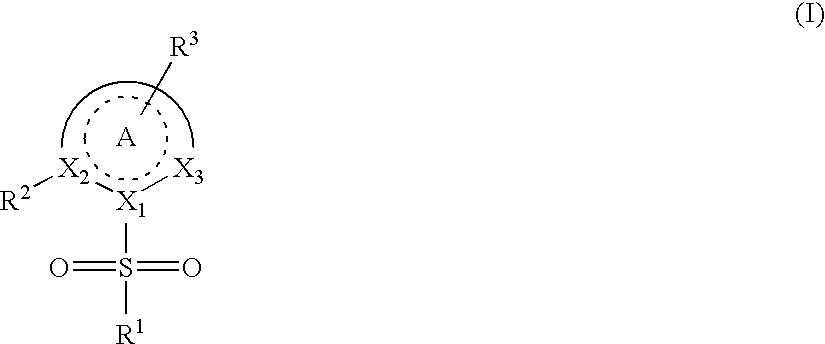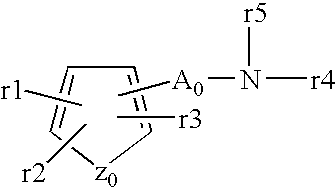Acid Secretion Inhibitor
a technology of acid secretion and inhibitory activity, which is applied in the direction of antibacterial agents, drug compositions, extracellular fluid disorders, etc., can solve the problems of side effects and effects of proton pump inhibitors, and achieve the effects of effective suppression of gastric acid secretion, improved stability, and superior treatment effect of peptic ulcer
- Summary
- Abstract
- Description
- Claims
- Application Information
AI Technical Summary
Benefits of technology
Problems solved by technology
Method used
Image
Examples
reference example 1
Methyl 4-methyl-1H-pyrrole-3-carboxylate
[0217]
[0218]To a suspension of potassium tert-butoxide (76.7 g) in tetrahydrofuran (900 mL) was added dropwise a solution of p-toluenesulfonylmethyl isocyanide (94.6 g) and methyl crotonate (48.5 g) in tetrahydrofuran (900 mL) over 30 min. The reaction mixture was stirred at room temperature for 3 hr, water was added, and the mixture was extracted with ethyl acetate. The extract was washed with saturated brine, dried over anhydrous sodium sulfate, filtered and concentrated under reduced pressure. The residue was purified by silica gel column chromatography (eluent:hexane-ethyl acetate=4:1) to give the title compound as a white solid (yield 16.8 g, 25%).
[0219]1H-NMR (CDCl3) δ: 2.29 (3H, s), 3.80 (3H, s), 6.53-6.54 (1H, m), 7.36-7.38 (1H, m), 8.25 (1H, brs).
reference example 2
Methyl 4-methyl-1-phenyl-1H-pyrrole-3-carboxylate
[0220]
[0221]To a solution of methyl 4-methyl-1H-pyrrole-3-carboxylate (1.70 g) in N,N-dimethylformamide (1.5 mL) were added iodobenzene (1.50 mL), potassium carbonate (2.19 g), L-proline (273 mmg) and copper iodide (232 mg), and the reaction was carried out in a microwave reactor (Emrys Optimizer manufactured by Personal Chemistry, 70° C., 1 hr). The reaction mixture was filtered through celite, water was added to the filtrate, and the mixture was extracted with ethyl acetate. The extract was washed with saturated brine, dried over anhydrous sodium sulfate, and concentrated under reduced pressure. The residue was purified by silica gel column chromatography (eluent:hexane-ethyl acetate=9:1→2:1) to give the title compound as a colorless solid (yield 925 mg, 35%).
[0222]1H-NMR (CDCl3) δ: 2.33 (3H, s), 3.82 (3H, s), 6.80-6.85 (1H, m), 7.20-7.50 (5H, m), 7.60-7.65 (1H, m).
reference example 3
Methyl 4-methyl-1-phenyl-5-(phenylthio)-1H-pyrrole-3-carboxylate
[0223]
[0224]To a solution of methyl 4-methyl-1-phenyl-1H-pyrrole-3-carboxylate (540 mg) in tetrahydrofuran (10 mL) were added N-iodosuccinimide (677 mg) and thiophenol (0.257 mL), and the mixture was stirred at room temperature for 2 days. Saturated aqueous sodium thiosulfate solution (10 mL) was added to the reaction mixture, and the mixture was extracted with ethyl acetate. The extract was washed with saturated brine, dried over anhydrous sodium sulfate, and concentrated under reduced pressure to give the title compound as a pale-yellow oil (yield 812 mg, about 100%).
[0225]1H-NMR (CDCl3) δ: 2.45 (3H, s), 3.85 (3H, s), 6.87 (2H, dd, J=7.8, 1.6 Hz), 7.05-7.40 (8H, m), 7.66 (1H, s).
PUM
| Property | Measurement | Unit |
|---|---|---|
| temperature | aaaaa | aaaaa |
| temperature | aaaaa | aaaaa |
| reaction temperature | aaaaa | aaaaa |
Abstract
Description
Claims
Application Information
 Login to View More
Login to View More - R&D
- Intellectual Property
- Life Sciences
- Materials
- Tech Scout
- Unparalleled Data Quality
- Higher Quality Content
- 60% Fewer Hallucinations
Browse by: Latest US Patents, China's latest patents, Technical Efficacy Thesaurus, Application Domain, Technology Topic, Popular Technical Reports.
© 2025 PatSnap. All rights reserved.Legal|Privacy policy|Modern Slavery Act Transparency Statement|Sitemap|About US| Contact US: help@patsnap.com



